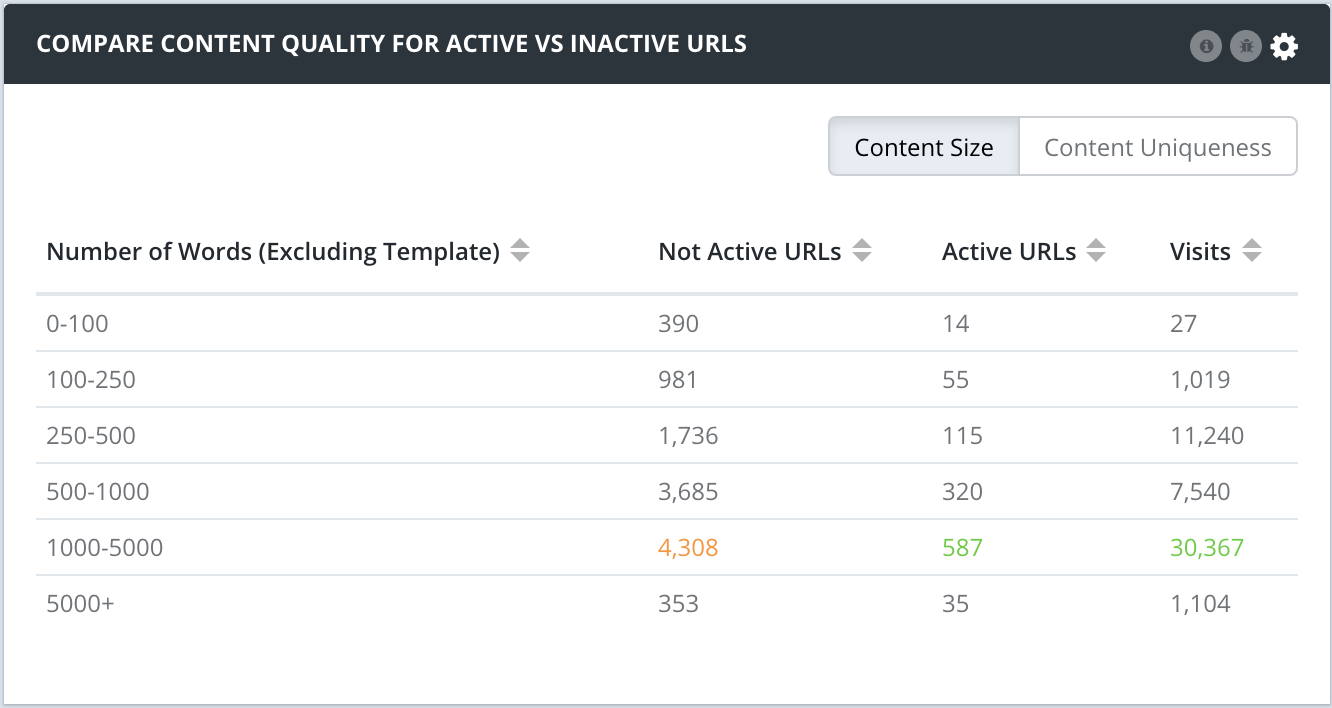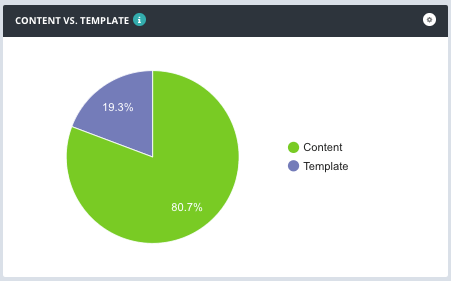Your Step-by-Step Guide to Performing a Content Audit for SEO


Removing content to rank better – sounds counterintuitive, right? It might sound strange, but pruning content can often result in better rankings and organic traffic overall because we’re directing Google away from our low-quality pages and toward our most powerful pages instead.
This process is known as an SEO content audit, and we’ll walk you through exactly what that is, the steps and categories involved, and tools to make the whole process easier.
Let’s dive in!
What is an SEO content audit?
An SEO content audit is a process that involves taking an inventory of your pages, evaluating their metrics, and taking action on low-performing pages. This “content spring cleaning” can help your website perform better in search engines like Google and Bing.
Why perform a content audit?
SEOs should consider performing a content audit because low-quality content can harm a website’s performance overall.
Low-quality content on some parts of a website can impact the whole site’s rankings, and thus removing low quality pages, merging or improving the content of individual shallow pages into more useful pages, or moving low quality pages to a different domain could eventually help the rankings of your higher-quality content.
Seems pretty clear! Removing or improving low-quality content can help your website perform better in search results.
If hearing it straight from the horse’s mouth wasn’t enough, many studies such as this popular example from Search Engine Journal have shown the benefits of content pruning.
Google also has finite resources to spend on your website content – don’t waste their time on low-quality pages! Make sure Googlebot’s time is spent crawling important, high-quality content.
When should I perform a content audit?
You might want to consider performing a content audit in the following situations:
- If your website has been around for a while and you’ve been steadily adding content to it
- If you just inherited a new client and you’re unfamiliar with the state of their content
- If your website has been experiencing steady declines in organic traffic
If your website is fairly new, doesn’t have much content, or is performing well organically, it’s not critical that you run through this process, but continually auditing content is a good best practice if you want to be proactive.
What am I looking for?
Content audits can reveal a lot about the state of your website. In this tutorial, we’ll walk you through how to find things like:
- Thin content
- Duplicate content
- Keyword cannibalization
- Impact of content quality on organic traffic
We’re trying to identify what low-quality content exists on the website and eliminate it so Google crawl budget isn’t wasted on low-quality pages.
What actions will I be taking?
The goal of a content audit is to find low-quality pages and improve them somehow so that we reallocate Google’s crawl toward our more powerful pages. The actions you take to address low-quality content on your website will depend as much on the type of issue you find as on your unique business goals.
For example, you might:
- Delete content that no longer serves a purpose
- Canonicalize exact duplicate (not similar) content
- Rewrite under-performing, but important content
Again, the actions you take are highly dependent on each specific situation. Don’t worry – we’ll walk you through it!
What makes content audits difficult?
- Performing a website crawl will return all your pages, provided they’re not orphaned, but not all of those will be relevant to a content audit, such as non-canonical versions of pages and pages marked as no-index (provided those directives are correct and you actually don’t want those pages in the index).
- The metrics you need to perform a thorough content audit usually come from a bunch of different tools, so you end up having to merge together data from multiple CSV files.
- Even with the help of some tools, content audits tend to be fairly manual, which is not conducive to large, enterprise-level websites.
Thankfully, Botify has a solution to make a lot of this easier.
How to Perform a Content Audit for SEO
One of the biggest benefits with Botify is that you can perform a content audit in a single tool. No jumping from tool to tool, no merging data from spreadsheets together. It’s faster and allows less room for error.
Before jumping into an audit though, you’ll want to segment your website into logical sections – usually by page type or template. This is essential for a good content audit for any website of substantial size because not only are the potential issues impacting each template different, but the content needs required to generate traffic will be vastly different for each based on the specific intent of the searcher those pages will serve.
Step 1: Make sure search engines are finding the right content
First, we suggest comparing indexable and non-indexable URLs.


Compliant URLs are pages that:
- Respond with an HTTP 200 (OK) status code
- Are not alternate versions of the pages (ex: non-canonical URLs)
- Have an HTML content type
- Are not marked with a No-Index tag
Essentially, compliant URLs are all the URLs you want Google to be indexing from your website, and non-compliant URLs are the ones that are sending some signal to Google that they should not be in the index.


Why do this?
Before content can do what you want it to do, search engines need to be able to find and understand it as you intend.
- By viewing non-compliant URLs, you may find pages that actually should be in the index
- By viewing compliant URLs, you may find pages you don’t want Google to be indexing
How to fix content indexing issues:
If you find important pages listed in your non-compliant URLs, check to see why they’re not compliant. In the screenshot above, you can see an example breakdown of non-compliant reasons. Once you know the reason for non-compliance, you can fix it. For example, if an important page is marked No-Index, you can remove that tag.
On the flip side, if you find compliant URLs that should not be in the index, you can:
- Delete and 301 redirect the URL to a similar page
- Add a rel=canonical tag indicating that the page is a copy of another URL
- Keep the page on the website but add a No-Index tag
The option you choose will depend on the unique nature of the page.
Step 2: Identify thin content & improve or prune it
Thin content tends to perform worse in rankings, so it’s a good idea to identify and address these pages. In Botify, you can do this by viewing pages by content size (word count).


What we love about this report is that it allows you to see the average word count of your pages, as well as distribution of page lengths by page type (such as articles). You can select “thin content” to drill down further and see a list of all pages with less than 100 words.
In many cases, thin content is coming from pages that you don’t want in the index anyway (ex: No-Index tag). What you care about is thin content that is available for indexing, which is why we like filtering this “thin content” report even further to view thin content only on compliant URLs.


Similarly, you can also view pages with mostly template content (ex: navigation menu, footer content, etc.) and very little main content by viewing the “content vs. template” report.


Why do this?
Google representatives have said that this form of content removal can actually improve your site’s performance overall. Removing or improving it in some way can result in ranking and traffic benefits.
How to fix thin content:
- Delete it: Thin content that serves no purpose, doesn’t rank well, doesn’t get any traffic, and has no inbound links usually can be deleted.
- Improve it: Thin content that does serve a purpose can be improved. If you’re wondering how to improve your pages, take a look at Google’s 23 questions for creating high-quality pages.
- Consolidate it: Thin pages may be able to be combined with another page, provided the content is relevant, to make one stronger page. Take the content from the thin page, add it to the other page, and 301 the thin content URL to the stronger URL.
Step 3: Identifying duplicate content
Find duplicate or near-duplicate content on your website by viewing the “Similarities/Duplicates” report in Botify.


In addition to pages with lots of similar content, you can view pages with similar topics.


Why do this?
Google has no duplicate content penalty, but they will try to serve up just one version of a page in search results. If your content is substantially duplicate with little-to-no added value to make it unique, it may not perform well in search engines.
How to fix duplicate content:
- Canonicalize: If the duplicate content needs to remain on the website, you can indicate to Google that another version of the page is the preferred version, and that one should be indexed instead. Remember, adding a canonical tag does not save crawl budget since Google has to crawl the URL in order to see the tag. Canonical tags are also suggestions – Google can ignore them.
- Delete & 301: If the duplicate content doesn’t serve a purpose, doesn’t rank or bring in traffic, and doesn’t have any inbound links, you could delete it and 301 redirect it to the page it’s duplicating.
- No-Index: If the duplicate page has no SEO value but needs to remain on the site, you could add a No-Index tag to tell Google to remove it from its index. This will also not save crawl budget, since Google has to crawl a page in order to see the No-Index tag.
- Rewrite: If the duplicate page needs to remain on the site and in the index, focus on making it more unique.
You can learn more in Google’s guide to addressing duplicate content.
Step 4: Find keyword cannibalization
Keyword cannibalization in SEO is when multiple pages on a website are ranking for a single keyword. This isn’t always bad. For example, some websites can hold multiple positions on page 1 for a single keyword, thereby maximizing their SERP real estate and potentially increasing the chances that someone will click on their result.
Keyword cannibalization becomes an issue when the “wrong” page from your website is ranking for a particular keyword, or both pages are ranking low for a particular keyword, and may rank higher as a combined, stronger page.
In Botify, just use Keywords Explorer to view keywords driving traffic to multiple URLs:


Why do this?
Again, it’s not always necessary to take action, but you may be competing with yourself! Combining competing pages could make the remaining page stronger and perform better in search results, as well as ensure that the best page is ranking for each query.
How to fix keyword cannibalization:
- Do nothing: If you’re ranking highly with multiple URLs for a particular query and the best page is already ranking highest, it’s probably best to leave the content as-is.
- Combine your pages: If your pages are ranking low (bottom of page 1 or lower), then that could indicate combining them into one stronger page would improve your ranking.
- Modify your pages: If multiple pages are ranking for a single query and the one that’s ranking most prominently is not your preferred page for that query, consider modifying your pages so that your preferred page is more optimized for that query and the others are differentiated from that.
Step 5: See how content quality is affecting organic traffic
Is thin content adversely affecting your organic visits? Is content uniqueness leading to an increase in organic traffic?
While it’s important to know what pages on your website are thin, duplicate, or non-unique, that data takes on a whole new layer of meaning when you compare it to organic traffic.
In Botify, you can view the number of organic visits by page length:


Or view how the size or uniqueness of the page might be impacting organic visits:


Why do this?
Pairing content quality with organic traffic allows you to see what characteristics might be having a negative or positive effect on your performance.
For example, from this report I’m able to glean insights such as:
- The most visited pages on my website are between 1,000 and 5,000 words
- The more unique pages receive slightly more organic traffic than less unique pages
- The least visited pages on my website have less than 100 words
How to fix content with low organic traffic:
If you notice a correlation between poor content quality and organic traffic, you can take action to correct it. For example, if pages with low word count are performing worse, consider adding unique, relevant content to those pages.
Important things to remember before any SEO content audit
While content audits have the ability to help you rank higher and get more organic traffic, deleting or otherwise removing the wrong things can have an adverse effect on your SEO performance.
How can you prevent a content audit from going sideways?
- Consider your content from all possible angles: Unify your data so you have all the evidence you need to make the best decision about your content. A page may show up in the thin content report, but is it getting traffic?
- Remember to look at links: Before removing content from your website, make sure you’ve checked its inbound links. If a page has quality links from other websites that you don’t want to risk losing, deleting the page will not be the best option.
- Look at the right data: If you’re not using a tool like Botify to perform your content audit, make sure you’re viewing analytics data from the Organic medium.
- Look at enough data: Pick a date range that gives you statistically significant data (ex: 12 months) and stick to it when analyzing each data set.
Performing a content audit doesn’t have to be a long, manual process. If you’re interested in seeing for yourself how Botify can help you audit your content and other website elements, book your demo today!
How to Perform a Content Audit?
- Make sure search engines are finding the right content
First, we suggest comparing compliant and non-compliant URLs.

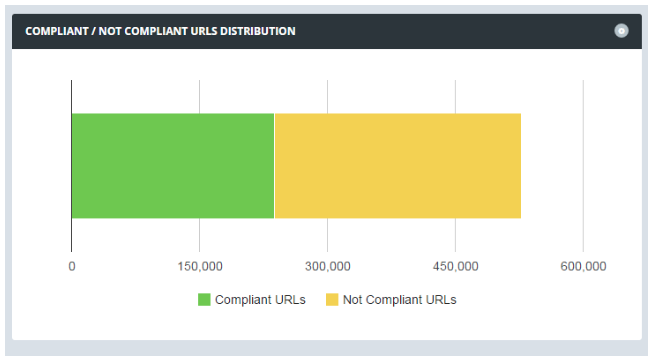
- Identify thin content & improve or prune it
Thin content tends to perform worse in rankings, so it’s a good idea to identify and address these pages. In Botify, you can do this by viewing pages by content size (word count).

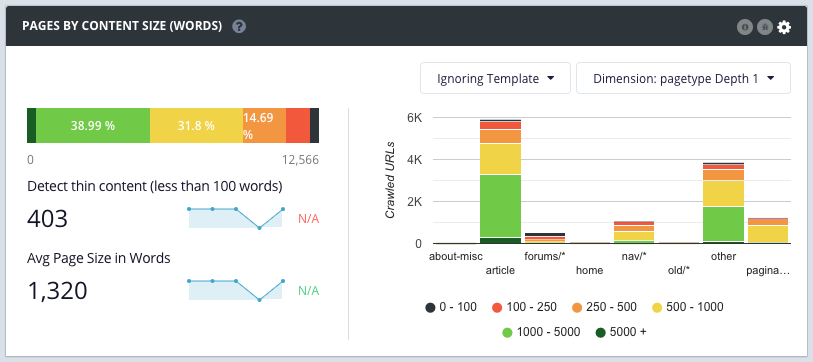
- Identifying duplicate content
Find duplicate or near-duplicate content on your website by viewing the “Similarities/Duplicates” report in Botify.

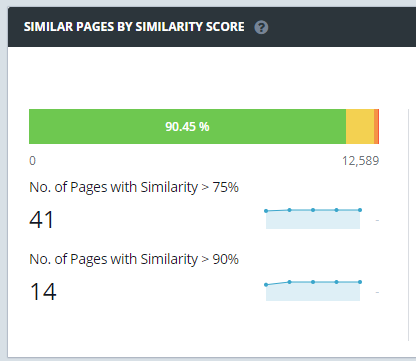
- Find keyword cannibalization
Keyword cannibalization in SEO is when multiple pages on a website are ranking for a single keyword. This isn’t always bad.

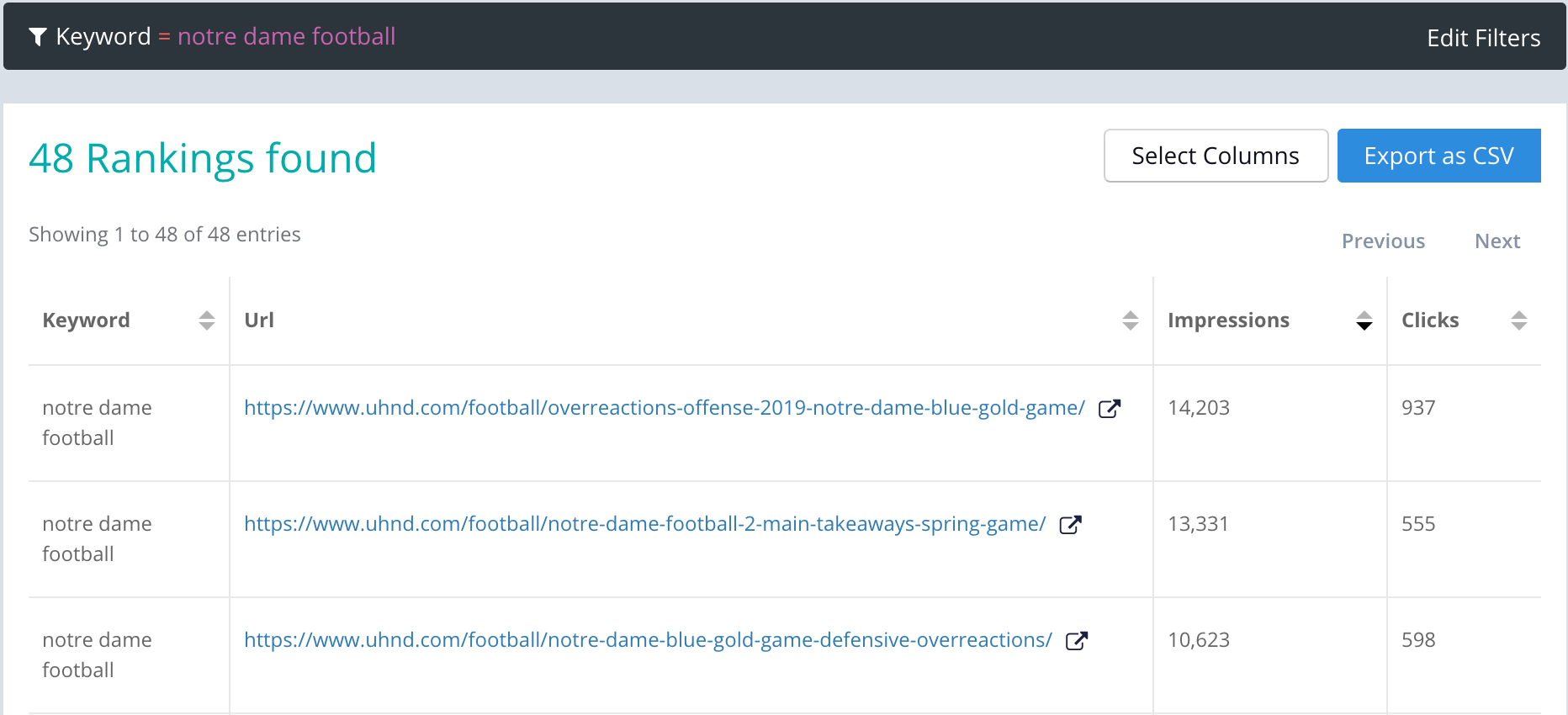
- See how content quality is affecting organic traffic
While it’s important to know what pages on your website are thin, duplicate, or non-unique, that data takes on a whole new layer of meaning when you compare it to organic traffic.

